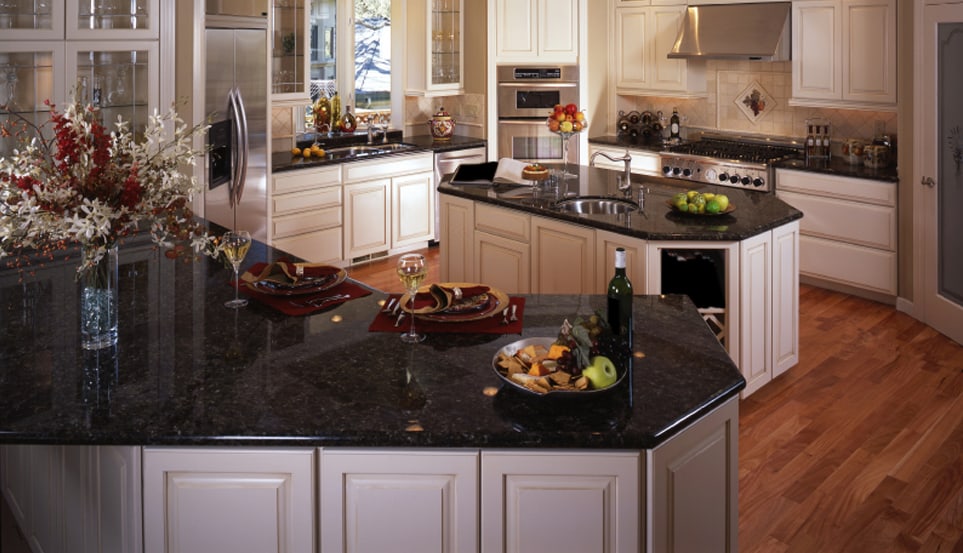Granite is a premium building material that stands out for its long-lasting beauty. When installed as countertops or flooring, granite provides distinction few other materials are able to.
However, in time, the gorgeous finish on granite will become worn, dulled and scratched. The stone must be polished to give it a new surface and restore the brilliant gleam.
What is Granite Polish?

When referring to “polish” on this page, we’re not talking about cleaners such as Lustro Italiano Stone Polisher and Rejuvenator. This is an outstanding product from Tenax, and its purpose is to clean away the day-to-day grime that accumulates on granite. In the process, it restores the gleam of a finely polished surface. Your granite surfaces should be cleaned in this manner as needed – as often as daily and as infrequently as every few weeks, depending on the type and volume of use it gets – and this is one of the very best products on the market.
The type of polish focus on from this point is polish that gives the granite an entirely new surface. It removes a small layer of granite – the layer that is dull, scratched and stained—to reveal fresh, smooth stone beneath.
How often you polish your granite is completely a matter of its appearance. Most granite surfaces require polishing every five to 15 years, depending on the traffic or use they receive.
Of course, polished granite must then be sealed to protect it from stains and other harmful issues, and that process is covered below.
Granite Polishing Options and Techniques
Granite can be polished with dry or wet material. Professionals are divided on the issue of which is better. Both techniques can be effective. Consider these pros and cons of wet granite polishing vs dry granite polishing:
- Dry granite polishing powder costs less than paste
- Powder granite polish can be used dry or wet, so it is more versatile
- Wet polishing creates a lot of spray when used with power tools, so wearing water-resistant clothing will protect you, and plastic sheeting should be used to protect walls, furniture and cabinets
- Wet polishing cools the pads which prevents them from becoming excessively hot and wearing out faster than they should
- Wet polishing pads are less expensive than dry pads
The manufacturer of your granite countertop or flooring might specify which type is most suitable for your product. Check its literature or website for details, or talk to a local pro for advice.
Granite polishing powder: Also called stone polishing compound, powder offers a quick and easy way to put a fresh gleam on granite while removing minor scratches and stains. If using it dry, choose a buff polishing pad to work the polish over the surface of the granite in a steady, circular pattern. When you prefer using granite polish wet, the best tool is a muslin wheel.
Many professionals rely on Dia-Glo Stone Polishing Compound for use both on new granite in their fabricating shops and on used flooring and countertops in their clients’ homes and businesses. Dia-Glo is made in two separate formulas, Dia-Glo Stone Polishing Compound for Dark Granite and Polishing Compound for Light Granite.
When choosing which granite polishing compound to use, consider the primary color of the stone. If it is lighter than medium brown or has predominantly light highlights, then use the Dia-Glo Light. Granite with darker tones is best served by the Dia-Glo polishing powder for dark stone.
This stone polishing compound can be used dry or wet with the tools indicated earlier. The compound does the work, so excessive pressure should not be used during the process. Read the directions carefully and follow them closely, and you should experience remarkable results.
Dia-Glo polishing powder is used in commercial settings for both regular maintenance to keep floors looking fantastic and for floor restoration to remove damage caused by high traffic.
Another excellent compound is Tenax Granite Polishing Powder. Tenax is a leader in the stone-care industry, and this polish is highly rated. Pros use it to in the fabricating shop and on the job site to produce a factory-fresh glow on granite flooring, countertops and wall panels.
Tenax granite polishing powder is mixed with water. Clear directions are found on the container, so getting the mix right is very easy. Surfaces are buffed with felt pads while the polish restores the gleam. This is a top choice for maintenance and restoration.
Granite polishing cream: Most granite cream polish is designed specifically for countertops. It contains the type of light abrasives best suited to the rich stone used to manufacture premium finished granite.
One of the top products in this category is MB-20 Stone Granite Polishing Cream. It is ideal for putting the factory shine on new countertops or restoring the gleam to countertops that have been in place for any number of years.
Used by professionals, this stone polishing cream is suitable for use on engineered stone as well as natural granite. The proprietary blend of abrasives will improve the appearance of the surface immediately. MB-20 granite polishing cream is an excellent choice for the entire spectrum of granite hues from light to nearly black. Most countertop pros use MB-20 cream on a hog’s hair pad or similar material for buffing.
Is Polishing Granite a DIY Job?
Many homeowners, property owners and maintenance professionals do their own granite polishing without calling in stone pros. One of the reasons this is possible is the quality of the premium granite polishing products available. The right polishing powder or cream used according to the labeling produces a restored granite surface that looks like a skilled professional did the work.
Because the majority of the expense is in the labor to do the job rather than in the polishing material, there is significant savings in doing the work yourself.
Sealing Granite
Once you’ve put a fresh polish on your granite surfaces, they need to be sealed. This will maintain the gleam while protecting the porous stone from stains.
Our guide to sealing granite countertops is a good place to learn about the process and products required. Most professionals choose a penetrating sealer because they offer the best protection for granite. One of the top-rated sealers of this type is Protex Impregnating Stone Sealer from Tenax. It is suitable for granite, marble and other stone plus concrete too. Tenax Protex sealer offers outstanding protection against oil, juice, water and other stain producers.
Tenax Proseal is also a professional sealer but is more affordable than Protex. Proseal is a good choice for stone countertops that aren’t subject to food preparation or dirty, greasy dishes. Before applying the sealer, clean the countertops and give them plenty of time to dry to ensure the best adhesion of the product.
Two Tenax Ager products are excellent on granite that has a dull appearance or when you want to bring out the rich, varied highlights in stone. Tenax Ager Color Enhancing Stone Sealer is a more affordable option, and it is formulated for all natural stone products. It seals the stone while brightening the interesting hues found in it. This product offers a reliable seal and protection against stains.
Ager Tiger Color Enhancing Stone Sealer is a resin-based product that does wonders for the color of slate, granite and marble. Two coats of this sealer are applied: one before and one after the final polish. The outcome is a still-wet look that glistens while enriching the colors in natural stone and resin-enhanced stone products like quartz countertops.
Polish, seal and protect your granite countertops, and they’ll provide you with durable beauty for decades to come.
